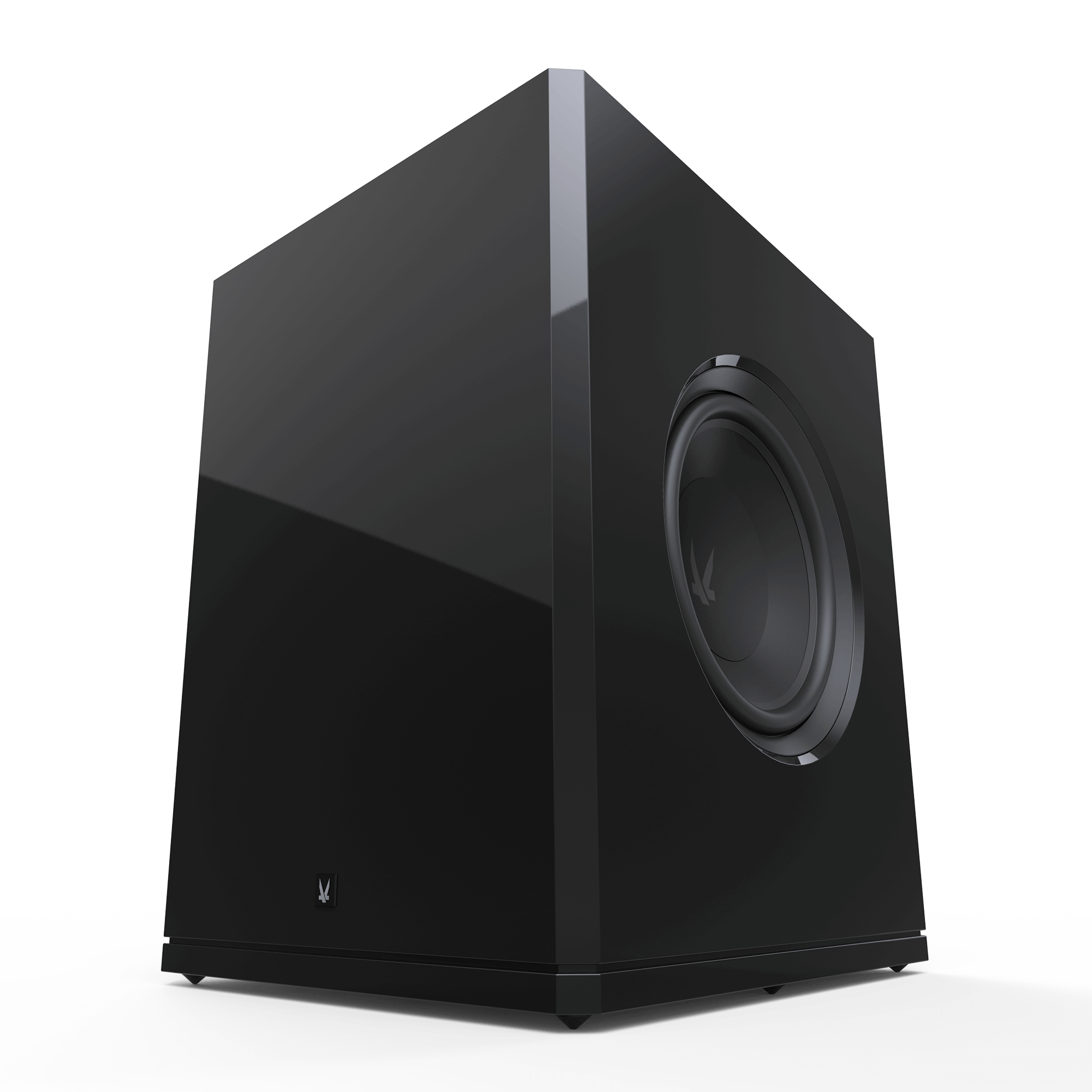OH MY! HIGHLY RECOMMENDED!
We have reviewed quite a few different subwoofers and some of them has actually been just as large as Arendal Sound’s Subwoofer 3, but they have hardly played both brutal and refined at the same time as they easily integrate with the rest of the system.
Already as the courier was unloading the subwoofer from the truck, I knew this was going to be a heavy experience – in several ways. Firstly the more than 60 kg heavy subwoofer needed to be dragged inside and connected, which demands quite a bit in terms of physics, but even when it started playing it got quite physical.
By Håvard Holmedal, Stereo+.
A power plant in its own right
The impression of Arendal Sound Subwoofer 3 is that they haven’t spared on anything. The cabinet is heavy and properly made, and the amplifier delivers what it promises and then some. The drivers, yes because there are two of them, are powerful and precise. They are 13.8-inches each and are designed just for this subwoofer. The amplifier is an Avalanche DSP1000 rated at 1000 Watt RMS in class D. That does not mean digital, but it means that it’s an amplifier that has good control in the bass, and that delivers superb dynamics. It also means that it can provide 1000 Watts continually, and for short periods considerably more. Therefore the power can get up to 2000 Watts.
The subwoofer obviously gets a lot of help from the amplifiers DSP, but the sound can also be adjusted by using the cabinet with the port open or sealed. That gives great adjustability to the room, but it is not only the frequency response that changes. In sealed mode it plays nicer and more even, but it does so at the cost of pure SPL. If you want it to roar with all its power, it is the mode with open port that needs to be chosen.
There are also two different EQ-modes to choose from. They give the subwoofer different behaviour and different frequency response in the deep bass.
The two drivers are mounted on each side of the cabinet. So they play against each other and thereby cancel a lot of the vibrations that arise in the cabinet. The result is higher price and larger demands for the amplifier, but you also get the possibility to play cleaner and with more volume. A pretty good compromise.
Placement
I’ve many good and expensive subwoofers that has played awfully, and a lot of cheaper subwoofers that has surprised a lot when we have been to shows or out in the stores to listen. At home I was having a bit more trouble with placement. One thing is that it’s heavy to drag around. Another is that it requires its space around itself, and that it makes anything in proximity vibrate. It is so cool when it works well, but not so cool when the kitchen-ware starts marching on a steady beat towards the edge of the cabinet and down towards the floor with destruction on mind.
Nevertheless it was quite clear where the subwoofer had to be placed for it to integrate best with the speakers and at the same time be as linear as possible. If there are too many dips you will feel loss in energy, and if there are too many peaks the sound will often be colored. The most important is still that if the subwoofer isn’t linear it will be very difficult to integrate with the speakers.
I ended up with a placement a little further out on the floor than I normally do, but it is not unexpected that it can’t stand on the “normal” place. With drivers on each side it triggers the inevitable standing waves in a slightly different fashion than with a single forward facing driver. But it does play loud, and to the degree where I hardly see which speakers that would be too big or play too loud. At least for speakers meant for home audio.
What makes a good subwoofer?
There are many things that are difficult when creating a subwoofer, but handling the forces that pull and drag in the entire construction is demanding. A little simplified, but we can at least mention the following: The cabinets need to be stiff and solid enough that they don’t vibrate during playback or that they radiate too much sound and resonances from large surfaces. In addition the sound on the inside of the cabinets must be stopped from playing out through the subwoofers. That requires damping on the inside reduces standing waves and reflections so that everything doesn’t just radiate out through the subwoofer driver. Remember that if it is 120dB on the outside, it is often that on the inside also. The subwoofer driver also needs to have control on what happens without breaking up of causing distortion. It isn’t possible, so the compromise must be to create least amount of distortion and least possible resonances and breakups in the driver. If these factors are not handled, the result is more or less noise in form of resonances and distortion, and everything affects how we perceive the sound of the subwoofer. A bad thing about noise is that this is not only kept to the frequencies played by the subwoofer. Even if you have the crossover set to 80Hz, you will easily have resonances and unwanted sounds up to several hundred Hz.
It makes problems for the lower midrange, masking details and coloring the sound. The effect is that we lose the feeling of precision, phase and dynamics. On top of this you will also “see” the subwoofer in the soundstage because the noise has components above the frequencies where the ear can place the origin of a sound. Usually the ear can not locate sounds with frequencies under 150Hz, but when there is noise above the same 150-ish Hz, you will easily disclose the origin of the sound. If it is first visible it will suck the entire soundstage towards it and destroy the focus and three-dimensionality of the soundstage. The louder and deeper you want to play, the larger the problem and the more expensive it is to fix it.
For music
If you want to play deep and loud you almost always need a subwoofer, also for playing music. I switched to EQ2 as I was using when reviewing the slightly smaller, but still impressive Subwoofer 2. In this mode there are no DSP-settings that pushes the driver further down than the natural roll-off of the cabinet. It gives the most natural and musical bass. I think it is at its best in this setting for music, even if the subwoofer doesn’t move down to under the 20Hz area. I play in a band that is called Unifaun because the other day I heard indications of a Moog Taurus some place there in the depth. And oh my. A bass tone deep as a well that makes my wisdom teeth rattle, seems to almost lie alarmingly far under the other tones. I look at my notes and play the same songs by Infected Mushroom as previously.
The powerful depth and weight paired with surprising amounts of suppleness and dynamics is not easy to find even from subwoofer at a far higher price than Arendal Sound Subwoofer 3. There is surprisingly little noise to hear, and the entire soundstage appears without coloration and with big precision, rhythm and timing.
The bass is also colorful and rich on musical content. There are plenty of subwoofers with a one-tone-bass, where the only thing changing is the volume. Here it is easy to hear the content in the deep bass-line on Song for Olabi, and there is nothing that disrupts either the percussion instrument or the vocals.
For movies
When watching movies I go over to the EQ1-setting. It is a setting where the DSP obviously helps to force the subwoofer down to ultra-bass-levels from 20Hz and below. It is so deep that you don’t need to play especially loud before you feel it getting more difficult to breathe. If you play loud on this setting, it is so powerful and cool that the bass alone is enough of a reason to watch a movie.
Even when it plays deep as a well there is an impressive calm over the whole experience. You need to stress the subwoofer quite a lot for it to break up, and there is extremely little unwanted noise to detect from the cabinet. But there is reason to come with a little warning. With powers like these, your room needs to be in good shape. You can not place a subwoofer like this in an ordinary living room and throw out all SPL-inhibitions out the door. In that case you need to secure pictures, lamps, glass goods and the inventory in your kitchen cabinets for good, before the session starts. Comprehensive damage on glass and loose parts are not covered – as far as we know, by a normal home insurance.
The cascades of deep, lovely bass is one thing. That there are other subwoofers that can as well, but as I experienced with the little brother, Subwoofer 2, it is also precise, explosive and very controlled.
What I also have registered is that both speakers and amplifiers I have at home doesn’t have close to the SPL needed to follow the subwoofer all the way to the finish line. Therefore I always lie at least 6-9dB under the max SPL of Subwoofer 3. What I am not pulling out in terms of SPL and weight, I get back in the shape of extra headroom, dynamic surplus and lower distortion, something that is also a good argument to buy a larger subwoofer than what you think you need, or perhaps an excellent excuse – if you need one.
Conclusion
This is a bomb of a subwoofer with power and SPL surplus in bucket loads, and with a defined and controlled playing style that suits even very expensive speaker systems. It is also flexible and even though both looks and size almost scream home theater, it is also superb for music.
STEREO+ THOUGHTS
Subwoofer 3 sounds breathtaking and violent and with surplus in heaps, and it plays movies and music equally well. You decide. Subwoofer 3 delivers.
We like
- Very potent and dynamic
- Controlled and defined
- Can be used for both movies and music
- Little noise
We don’t like



